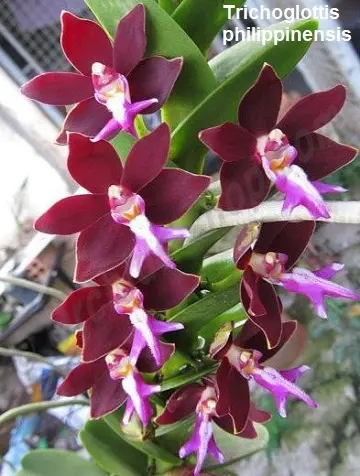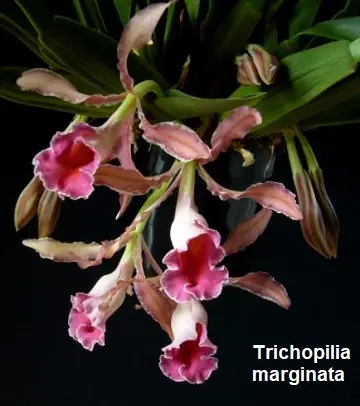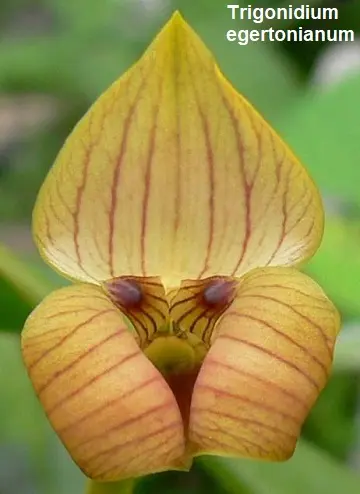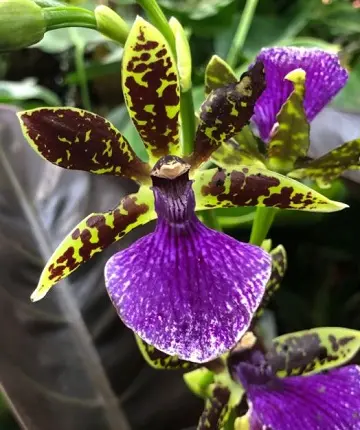 |
||
| Stelis
Over 600 species in this genus from the Ameircan tropics. Not widely grown, but the flowers are recognisable as 3 thick petals that look more like a pendant forget me not than an orchid. |
||
| Stelis sp | ||
| /\ Top of Page | ||
 |
||
| Stelis
Over 600 species in this genus from the Ameircan tropics. Not widely grown, but the flowers are recognisable as 3 thick petals that look more like a pendant forget me not than an orchid. |
||
| Stelis ciliaris | ||
| /\ Top of Page | ||
 |
||
| Trichoglottis 60 species from East Asia , Malaysia, the Philippines, and the Polynesian islands. Epiphytic with monopodial stems and small solitary flowers appear at the leaf axils. |
||
| Trichoglottis philippinensis | ||
| /\ Top of Page | ||
 |
||
| Trichopilia A genus of 29 species distributed from Mexico, Bolivia to Brazil. Characterised by flattened pseudobulbs with a single leaf, thes epiphytes grow on embankments or wet forest. They are easy to grow under intermediate conditions. |
||
| Trichopilia marginata | ||
| /\ Top of Page | ||
 |
||
| Trichopilia A genus of 29 species distributed from Mexico, Bolivia to Brazil. Characterised by flattened pseudobulbs with a single leaf, thes epiphytes grow on embankments or wet forest. They are easy to grow under intermediate conditions. |
||
| Trichopilia tortilis x turialbae | ||
| /\ Top of Page | ||
 |
||
| Trichopilia A genus of 29 species distributed from Mexico, Bolivia to Brazil. Characterised by flattened pseudobulbs with a single leaf, thes epiphytes grow on embankments or wet forest. They are easy to grow under intermediate conditions. |
||
| Trichopilia turialbae | ||
| /\ Top of Page | ||
 |
||
| Trigonidium A genus of 16 species from tropical America, ranging from Mexico down to Bolivia & Brazil. Flowers arise singly from the base of the pseudobulbs and are unusual in their form. |
||
| Trigonidium egertonianum | ||
| /\ Top of Page | ||
 |
||
| Trudelia A genus of 6 species from Nepal and Thailand with one found in Indonesia. Floaers are waxy white to green with maroon stripes. They are monopodial epiphytes closely related to Vandas . |
||
| Trudelia cristata | ||
| /\ Top of Page | ||
 |
||
| Vanda
A genus of 50 species from Southern India down through Asia into the Philippines. They are generally large monopodial epiphytes with stout leafy stems. Often grown in a barket with no or very little planting material. They prefer intermediate to warm temperatures. |
||
| Vanda tricolor | ||
| /\ Top of Page | ||
 |
||
| Vanda
A genus of 50 species from Southern India down through Asia into the Philippines. They are generally large monopodial epiphytes with stout leafy stems. Often grown in a barket with no or very little planting material. They prefer intermediate to warm temperatures. |
||
| Vascostylis 'Thai Sky' | ||
| /\ Top of Page | ||
 |
||
| Xylobium around 22 species make up this genus that ranges from mexico down to Brazil. Soft ribbed leaves on top of oviod pseudobulbs, flowers on upright racemes rise from the base of the bulbs. Intermediate to warm temperatures required. |
||
| Xylobium squalens | ||
| /\ Top of Page | ||
 |
||
| Zygopetalum
There are 16 species that make up this genus that is found in South America. The plants grow as epiphytes or terrestials in wet forests. The prefer cool to intermediate and an abundance of water. |
||
| Zygopetalum A species from Brazil, the flower inflorescence can reach a meter tall with up to 10 blooms, and the flowers 8 cm wide. Best in pots with plenty of water especially during the growing season. |
||
| /\ Top of Page | ||